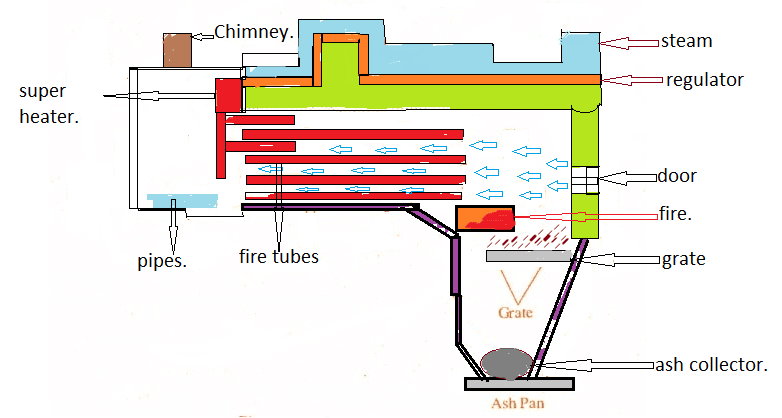Locomotive boiler
Locomotive Boiler: Locomotive boiler is the type of horizontal fire tube boiler it has multi-tubular combustion takes place ingrate by the supply of coal into Locomotive Boiler. Locomotive Boiler is also called as fire tube boiler. Locomotive Boiler is used to create steam from water by using heat energy.
Main parts of Locomotive Boiler:
Locomotive Boiler has Different Parts they are as follows:
- Firebox
- Cylindrical shell
- Smoke box
- Chimney
- Grate
- Ash pan
- Super heater tubes
- Valves
- Damper etc.
Working Principle of Locomotive Boiler:
- The locomotive boiler is the type of horizontal fire tube boiler it has multi-tubular combustion takes place ingrate by the supply of coal into it, Hot flue gases deflects by the fire bridge this flow into the fire tubes. by this fire tubes, the hot gases are used to flow through the cylindrical shell and enter into horizontal tubes in it.
- In this, the water is heated by hot gases and formed into saturated steam this steam collects at the top of the shell. this saturated steam gets into the steam pipe and goes into super heater header by this steam gets super heated, this super heated steam used to supply to the engine. the gases in the tubes are discharged into the atmosphere by the help of chimney after passing through the smoke box.
- The steam capacity is about 9000kg/hr, and efficiency is about 70%, working pressure is about 14bar.
Limitations of Locomotive Boiler:
- In this Scale is used to form in it. and also corrosion formation may occur in it.
- It needs a large flat surface
- When there are heavy loads it gets overheated.
- It has low efficiency.
- Advantages:
- This type of boilers is used to produce high steam rate.
- the draught losses are less compared to other boilers.
- It has a low construction cost. and very compact.
Uses:
- This type is used in marines, locomotive engines in railways.
Please Subscribe! and Don’t forget to Follow us on Facebook, Twitter, Linkedin, Instagram and Google Plus.



